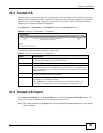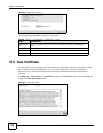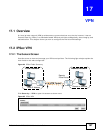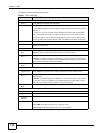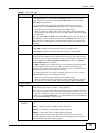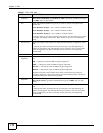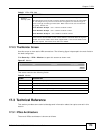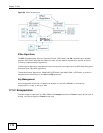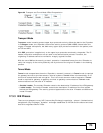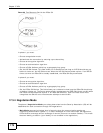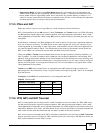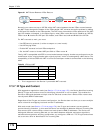
Chapter 17 VPN
FMG3024-D10A / FMG3025-D10A Series User’s Guide
171
Content When you select IP in the Local ID field, type the IP address of your computer
in the Content field. If you configure the Content field to 0.0.0.0 or leave it
blank, the Device automatically uses the Pre-Share Key (refer to the Pre-
Share Key field description).
It is recommended that you type an IP address other than 0.0.0.0 in the
Content field or use the DNS or E-mail ID type in the following situations.
• When there is a NAT router between the two IPSec routers.
• When you want the remote IPSec router to be able to distinguish between
VPN connection requests that come in from IPSec routers with dynamic WAN
IP addresses.
When you select DNS or E-mail in the Local ID field, type a domain name or e-
mail address by which to identify this Device in the Content field. Use up to 31
ASCII characters including spaces, although trailing spaces are truncated. The
domain name or e-mail address is for identification purposes only and can be
any string.
Remote ID Select IP to identify the remote IPSec router by its IP address.
Select DNS to identify the remote IPSec router by a domain name.
Select E-mail to identify the remote IPSec router by an e-mail address.
Content The configuration of the remote content depends on the remote ID type.
For IP, type the IP address of the computer with which you will make the VPN
connection. If you configure this field to 0.0.0.0 or leave it blank, the Device will
use the address in the Secure Gateway Address field (refer to the Secure
Gateway Address field description).
For DNS or E-mail, type a domain name or e-mail address by which to identify
the remote IPSec router. Use up to 31 ASCII characters including spaces,
although trailing spaces are truncated. The domain name or e-mail address is for
identification purposes only and can be any string.
It is recommended that you type an IP address other than 0.0.0.0 or use the
DNS or E-mail ID type in the following situations:
• When there is a NAT router between the two IPSec routers.
• When you want the Device to distinguish between VPN connection requests
that come in from remote IPSec routers with dynamic WAN IP addresses.
Security Protocol
Pre-Shared
Key
Type your pre-shared key in this field. A pre-shared key identifies a
communicating party during a phase 1 IKE negotiation.
Type from 8 to 31 case-sensitive ASCII characters or from 16 to 62 hexadecimal
("0-9", "A-F") characters. You must precede a hexadecimal key with a "0x” (zero
x), which is not counted as part of the 16 to 62 character range for the key. For
example, in "0x0123456789ABCDEF", “0x” denotes that the key is hexadecimal
and “0123456789ABCDEF” is the key itself.
Advanced Setting - Phase 1
Encryption
Algorithm
Select which key size and encryption algorithm to use in the IKE SA. Choices
are:
3DES - a 168-bit key with the DES encryption algorithm
AES128 - a 128-bit key with the AES encryption algorithm
AES256 - a 256-bit key with the AES encryption algorithm
The Device and the remote IPSec router must use the same key size and
encryption algorithm. Longer keys require more processing power, resulting in
increased latency and decreased throughput.
Table 51 IPSec VPN: Add
LABEL DESCRIPTION



